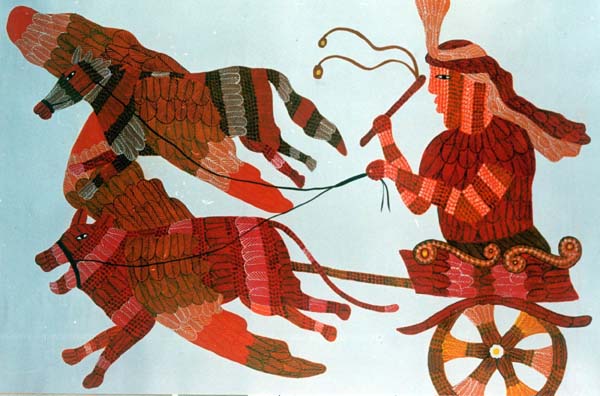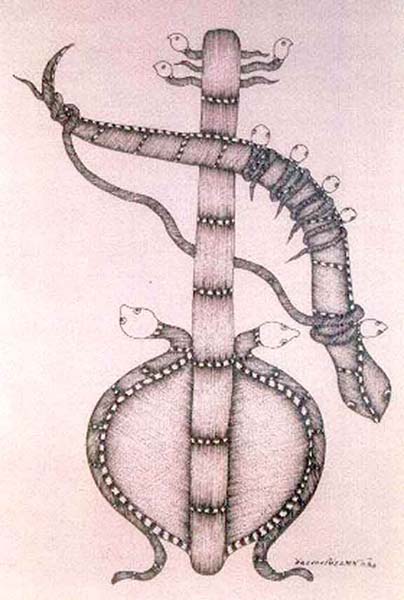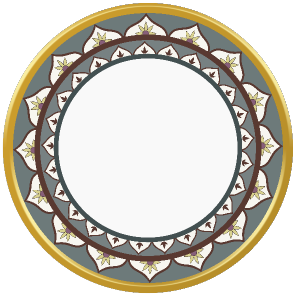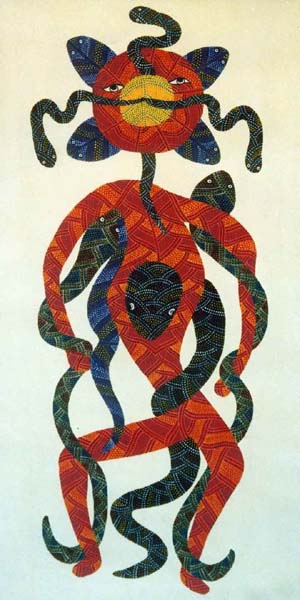Know the traditional art of India, Gond Art- an indegenous art form
Indigenous
art has seen a sudden spurt of popularity in the last couple of decades. Once recognized and bought by only those who ‘knew’ about art, and who were aware of the existence of this art and its artists, indigenous art has now made a claim for fame. Gond art is one such indigenous art, which was once done on the walls of village homes in some areas of Madhya Pradesh, but which has become so popular that some artists like Venkat Shyam, who now stays in Bhopal, have their works displayed in art galleries in India and abroad.

Painting by Venkat Shyam
- Area of Origin: This art belongs to Gondwana region. However, there are several other forms of art being practiced in the Gondwana region. So the real name of this art form, according to Venkat Shyam, is different. “I call it Pradhan Kala since it is done by this particular community called Pradhan. We used to call it ‘bhitichtra’ earlier. But now this is popularly known as Gond art, for some reason.”
- Colours Used: Venkat Shyam says, “Only natural colours were used in the earlier art. Yellow, red, black, green and white were the basic colours we used. Yellow we get from clay. This, when roasted, gives us what we call Indian Red. Leaves give us the green. ‘Tesu’ flower gives us yellow and then can be processed to give us orange. Bougainvillea also gives us some colours, namely yellow, pink, purple and dark Indian red. Blue I have never used in natural colours because we don’t have them. But now we use all the colours, and the paints used are often acrylic. Multi-media is the term, where anything can be the canvas and any paint can be used.”

Painting by Venkat Shyam
- Style of Painting: According to Venkat Shyam, the basic style was regular for all, and it was mainly done with the use of dots. There was no stylization earlier. There was no personal artist signature. But slowly artists of Gond art began developing their own personal style, developing their own patterns like a dot, double dot, semi-circle etc. But now everyone copies this and so it is no longer confined and known as one artist’s style.
- The Themes of the Paintings: The themes are varied. Often, themes from mythology form the basis of such paintings. However, they are often juxtapositioned with other elements to create character, contrast or surprise. For example, Venkat Shyam says he often uses one solid main figure as the theme of his painting, e.g. Hanuman from the Ramayana, and then puts other elements in the painting that relate to Hanuman like the burning tail, the love for Ram, and anything else he wishes to include.
- The emergence of Hybrid Works: Those not familiar with this work sometimes mistake it for Madhubani, though both art forms differ in origin and style. With the popularity of Gond paintings, people doing Madhubani art have now begun to adopt the style of Gond art paintings, and so a kind of hybrid art has emerged. Also, in recent Gond paintings, a hybrid style has emerged to suit the contemporary tastes and demands.
Very often people have found the drawings to be very basic and think they have been done by children. In this, lies our ignorance and lack of knowledge of our own country’s myriad arts, their origins, and their forms. After its universal recognition, people have begun to value this art that was once done on the walls of village homes. These paintings can now be found in art galleries and designer offices and homes.
To know about Indian art and culture, follow us on
Facebook,
Instagram, and
Twitter.






 Painting by Venkat Shyam
Painting by Venkat Shyam
 Painting by Venkat Shyam
Painting by Venkat Shyam